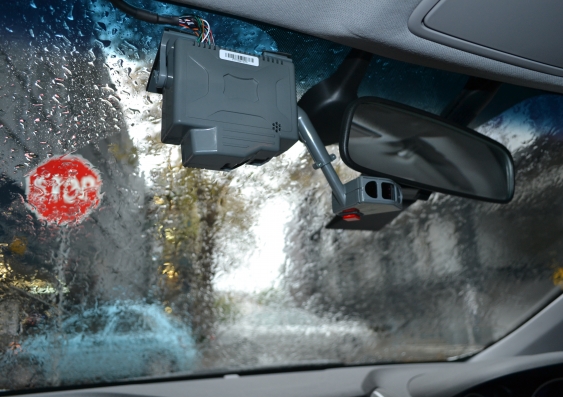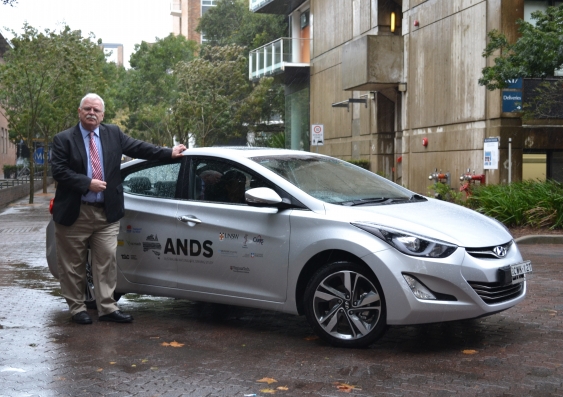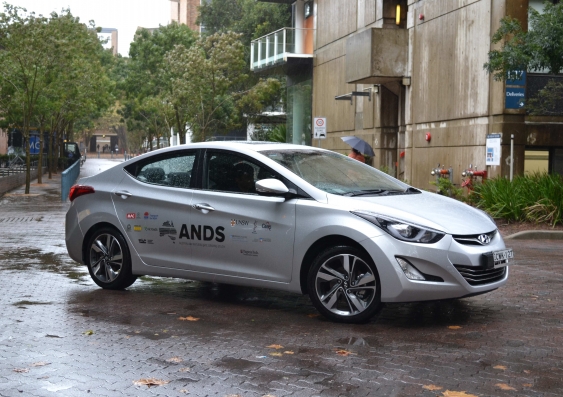Making our roads safer – Australia's biggest driving study
Drivers are being sought to have their cars fitted with world-leading technology as part of a $4 million UNSW-led study into everyday driving behaviour.
Drivers are being sought to have their cars fitted with world-leading technology as part of a $4 million UNSW-led study into everyday driving behaviour.

An Australian-first study into everyday driving behaviour, led by road safety scientists at UNSW in collaboration with Transport for NSW and university, government and industry partners has been launched by UNSW Vice-Chancellor, Professor Ian Jacobs.
180 NSW drivers are being sought to volunteer for the ground-breaking research and have their cars fitted with world-leading technology that will detect how they react to sudden events during normal driving, and how they interact with other road users, such as pedestrians and cyclists.
The $4 million Australian Naturalistic Driving Study aims to enrol 360 male and female drivers in total from NSW and Victoria, aged between 20 and 70, who hold a full driver’s licence. Participants will receive $250 in gift vouchers and can register at www.ands.unsw.edu.au.
The unobtrusive and compact equipment to be installed in each driver’s car for a four-month long period will include radar, GPS, and video cameras that silently record where the driver is looking, the view from the front and rear of the vehicle, and whether pedestrians and cyclists are nearby. Other sensors will detect speed, lane position, swerving and sudden braking (see below for details of the technology).
“The aim of our research is to save lives and prevent serious injuries,” says study leader, UNSW Professor Raphael Grzebieta.
“This is the first driving study of this magnitude and sophistication in Australia. It will provide an invaluable record of the behaviour of drivers, their cars and other road users in real world situations.
“With this technology we will learn how people avoid collisions or other safety-related incidents in everyday driving. The study will also reveal new information on human factors such as distraction, inattention, speeding, aggression and tiredness, which are often the main culprits in collisions.”
The UNSW-led Australian Naturalistic Driving Study aims to understand what people do when driving their cars in everyday and safety-critical situations.
Professor Jacobs says the study is a truly imaginative collaboration between federal and state governments, universities and industry, as well as taking an innovative approach to reducing road deaths. "It's about the near misses. And it is using really modern technology to collect a vast amount of data and then analyse that data to inform safety on our roads."
Transport for NSW Manager Road Safety Technology, John Wall, says: “With this new study – what we’re calling reality TV for road safety – we’re on the cusp of obtaining ground-breaking information that will change the way we approach road safety.
“We know the people of NSW are passionate about road safety – we work closely with the community on a range of issues and have received over 1900 nominations via the Safer Roads website for speed cameras. This is another way the community can partner with us and make the roads safer for everyone.”
NRMA Senior Policy Advisor, Jack Haley, says: “The human element is the weakest link in any matter of active safety. NRMA looks forward to this study’s insights and answers.”
About 1300 people die and 33,000 more are seriously injured each year on Australian roads and the estimated cost of road trauma to the Australian community is about $27 billion a year.
Most evidence about crashes and road trauma comes from data collected after the event by police, coroners, hospitals, and licencing and registration authorities.

One of two Hyundai cars equipped with world-leading technology with study leader, UNSW Professor Raphael Grzebieta.
“This innovative new study will reveal what happens before crashes and in near misses or small collisions that are not reported to the police. The results will be used to develop new road safety programs, policies and products that will help save many lives and prevent many serious injuries,” says Professor Grzebieta, of UNSW Transport and Road Safety Research.
It will determine how drivers deal with hazards such as busy intersections that have no traffic lights, and difficult driving situations such as pedestrians unexpectedly crossing the road or other drivers engaging in risky behaviour.
The results will be used to develop new and improved evidence-based countermeasures for enhancing intersection safety; reducing crashes related to speed, fatigue and inattention; reducing fatal and serious injury crashes involving vulnerable road users such as pedestrians and cyclists; and improving the design and performance of intelligent vehicle-safety technologies including collision-warning technology.
The Naturalistic Driving Study research method was pioneered by Virginia Tech Transportation Institute in the US, which is a partner in the Australian study. The study website, www.ands.unsw.edu.au, has a video and more information explaining the study.
The study is led by UNSW in collaboration with Monash University, Queensland University of Technology, the University of Adelaide and Virginia Tech.
Government and industry partners include the NSW Centre for Road Safety at Transport for NSW, NRMA, the Transport Accident Commission in Victoria, VicRoads, the Motor Accident Commission in South Australia and the Western Australian Office of Road Safety.
The project receives funding from the Australian Research Council. Hyundai Australia has also provided two cars for the project.
TECHNOLOGY DETAILS
Cars will be installed with world-leading technology including sensors and data-logging equipment that operate continuously while the vehicle is turned on.
The equipment includes:
Video cameras that continuously monitor the roadway ahead and behind the vehicle
Video camera to record where the driver is looking
Stills camera to take an occasional blurred snapshot of the vehicle interior to determine the number of passengers without identifying them
GPS to provide the location of the vehicle
Lane tracker software to detect deviations from lanes
Front radar to detect distance to the vehicle in front and track up to six independent targets
Accelerometer to detect sudden stops, starts and turns
Sensors to detect ambient light, temperature and swerving, and use of turning signals
Alcohol sensor to detect the presence of alcohol in the car, although not its source
Mobileye sensor to detect if the car is speeding, is too close to the car in front, about to have a collision or veer off-road
The sensors will not issue any warnings nor prevent collisions from occurring. Audio will not be recorded unless the driver pushes a red button to describe an incident such as a near miss or a crash.

The ANDS Hyundai car